Tourtière is a French-Canadian meat pie with spices and a double crust. It is an important part of the Christmas and New Year’s celebrations in Quebec and for those of French-Canadian ancestry.
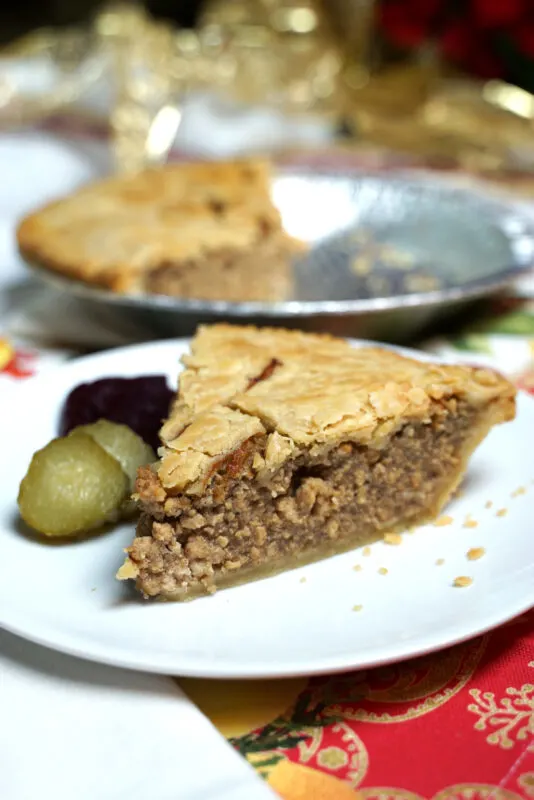
The history of tourtière meat pie
Meat pies are not exclusive to Canada, by any means.
You find them referenced through history, with versions even as early as Mesopotamia.
Roman kings added their own twists and then spread the concept throughout Europe. The Middle Ages also saw a great love for meat pies.
You’ll find meat pies of all sorts across the globe. Empanadas in Latin America. Samosas in India. And traditional mincemeat pies for the British Christmas table. (Traditionally those were made with meat, unlike the more common mince pies made with fruit that you find today.
Meat pies in Canada date back to when Quebec was a French settlement.
While it is thought tourtière goes all the way back to the early 1600s, the first written recipe appears in an 1840 cookbook, La cuisinière canadienne.
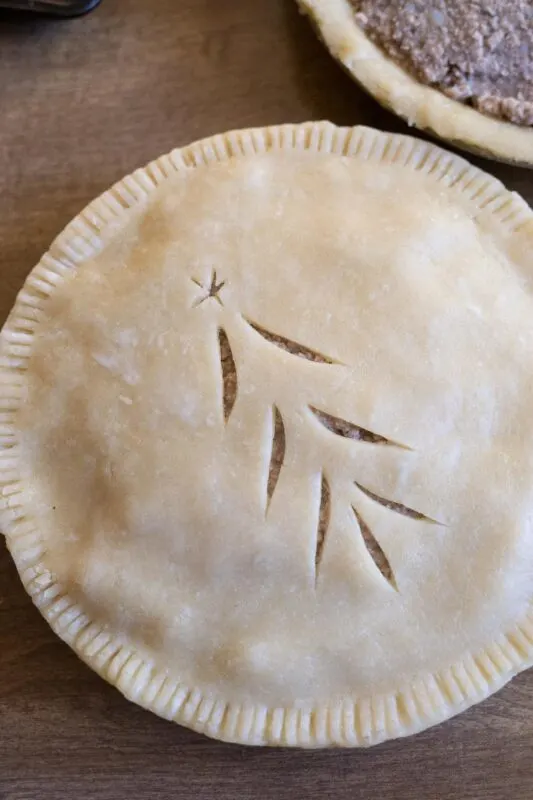
Why is it called tourtière?
Some believe that the name of the pie comes from now extinct passenger pigeons, called ‘tourtes’, that were used in the original pies.
Others prefer to believe that the name comes from the deep baking dish that families would traditionally use to cook their pies, also called a ‘tourte’.
What is tourtière made of?
Also known as pork pie or meat pie, tourtière is made with ground meat, onions, and spices all baked in a double pie crust.
It is the particular spicing mixture that makes this pork pie so special to those who call this pie a Christmas tradition, and enjoyed by everyone who is introduced to it.
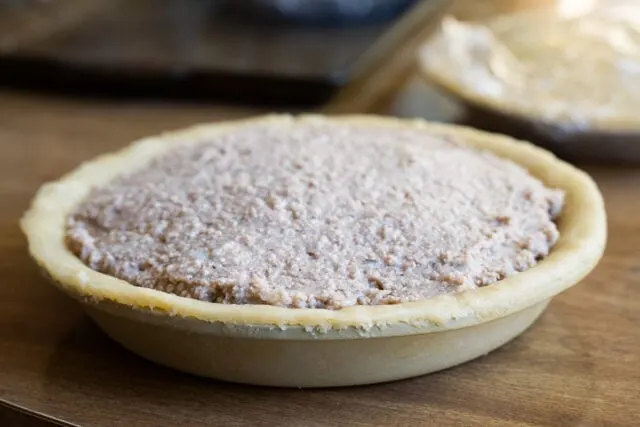
What meat is used in tourtière?
Traditionally tourtières were made with many different types of wild game including the previously mentioned pigeon.
Nowadays, pork, beef, and veal are commonly used.
In my family we call these ‘pork pies’ because pork is what my French-Canadian grandma used and what my mom still uses every year when she makes these pies for family and friends.
While the meat would have been chopped finely with a knife in the early versions, most cooks today use ground meat. Which is much easier, but does result in a bit of a different texture than the original tourtières would have had. (But, if these original ones used pigeon, I think I’m perfectly ok with the way this recipe has evolved through the centuries.)
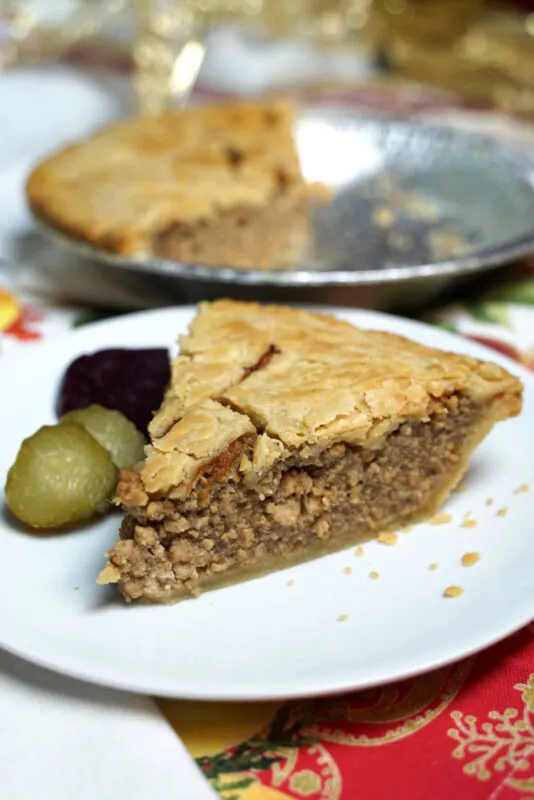
When do you eat tourtière?
It is a much-loved tradition to serve this meat pie on Christmas Eve.
Traditionally, no meat was eaten on Christmas Eve until after midnight Mass. French-Canadians would come home after midnight Mass (called the Reveillon) and start their Christmas celebration by sitting down with family and enjoying tourtière.
Many families also eat tourtière on Christmas Day and New Years day.
I have fond memories of going to Christmas Eve Mass in Maine with my French-Canadian Grandparents (typically is was just after dark, and not true midnight Mass). We would return home to a late dinner of pork pie, with all the fixings.
What is traditionally served with tourtière ?
In our family, we always serve our Christmas Eve pork pie with a large spread of pickles. Dill pickles, sweet pickles, pickles beets. I even remember pickles onions and pickles eggs showing up in random years.
If pickles aren’t your thing, I have heard of families serving it with mashed potatoes and gravy. (But there are mashed potatoes in the pie itself.)
We have also served a salad or steamed broccoli with it in an effort to bring more vegetables into the meal.
You can eat tourtière hot, warm, or cold. (I personally love a cold slice of pork pie for breakfast – it reminds me of Christmas morning!)
However you eat it, be sure to serve it with ketchup and mustard!
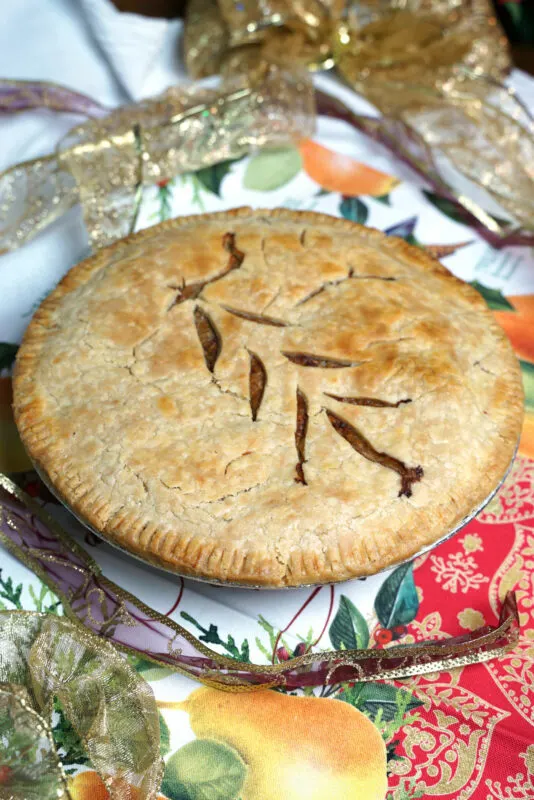
Can meat pie be frozen?
Yes! Every year my Mom makes a bunch of pork pies early in her Christmas preparations and freezes them for our Christmas meals and for friends.
If you plan to freeze the pies, be sure to use fresh meat (not frozen).
My mom prefers to freeze the pork pies un-baked. To bake them you thaw in the refrigerator overnight and bake from a cold oven for roughly 1 1/2 – 2 hours.
Tourtière (French Canadian Pork Pie)
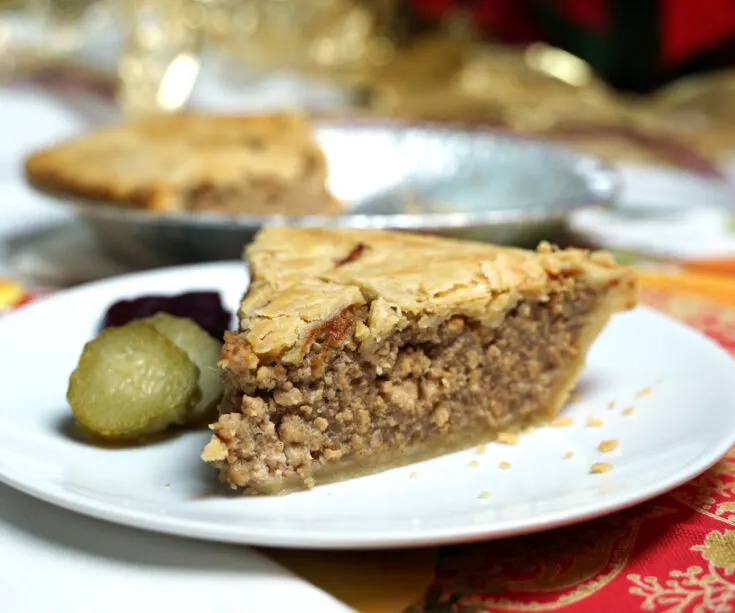
Tourtière is a French-Canadian spiced meat pie with a double crust. It is an important part of the Christmas and New Year’s celebrations in Quebec and for those of French-Canadian ancestry.
Get all of your ingredients ready before starting the meat filling mixture: have your meat ground, spices measured out in a little bowl, potatoes mashed, and pie crust dough ready to be rolled out.
Ingredients
- Ingredients
- 1 tsp oil or butter
- 1 small onion, minced
- 1 ½ lbs lean ground pork*
- 1 tsp salt
- ¼ tsp pepper
- ¼ tsp ground celery seed
- 1/8 tsp sage
- 1/8 tsp marjoram
- 1/8 tsp cinnamon
- Dash ground allspice**
- 1 1/2 c mashed potatoes***
- Unbaked pastry dough for a double-crusted 9 inch pie****
Instructions
- Sauté the minced onion in the oil or butter in a heavy-bottomed pot or skillet with high sides over medium high heat.
- Once the onions are translucent, add the ground pork and spices. Cook until the meat has browned, stirring often.
- Remove your pan from the heat and add the potatoes to the un-drained meat mixture. (This is if you are using lean meat. If you’re not sure if your meat is lean and you think you have A LOT of fat in there, then drain some off.)
- Roll out slightly more than half of your pie crust dough for the bottom crust. Place it into a 9 inch pie dish.
- Fill the crust with your (slightly cooled) meat filling mixture.
- Roll out the remainder of your crust dough for your top crust. Cut some air holes into the top crust.
- Moisten the edges of the bottom crust with a little water on your finger. Place the top crust over the filling. Press the two crust edges together to seal, fluting with your fingers or adding a decorative edge with the tines of a fork, if desired.
- If baking your pie immediately: Preheat your oven to 400F. Cover the edges of the pie with a strip of aluminum foil. (If you are using an aluminum pie tin, place the tin on a baking sheet.) Place the pie in the preheated oven and bake for 20-30 minutes. When the center starts to brown, pull off the aluminum foil from the edges and let the pie continue to cook until the edges are golden brown (30-40 minutes).
- If freezing immediately: Let the filing in the prepared pie cool completely before Wrap the pie in plastic wrap and place in a Ziploc bag. The pie will keep frozen like this for up to a year.
- To bake from frozen: Take the pie out of the freezer the night before and let thaw in the refrigerator overnight. Cover the edges of the pie with a strip of aluminum foil. (If you are using an aluminum pie tin, place the tin on a baking sheet.) Place the cold pie in a cold oven. Turn your oven to 400F. Allow the oven to preheat with the cold pie in it. Once the oven is up to temperature, bake for 1 1/2 – 2 hours, until a knife stuck in the center comes out warm or a thermometer inserted in the center reads 160F and your crust is golden brown. Pull the foil off of the edges for the last 10-15 minutes of baking.
- To warm a pre-cooked (but not frozen) pie: Cover the edges of the pie with a strip of aluminum foil. (If you are using an aluminum pie tin, place the tin on a baking sheet.) Place the pie from the refrigerator into a cold oven. Turn the oven to 350F. Once the oven is up to temperature, reheat for 30 minutes, until a knife stuck in the center comes out warm or a thermometer inserted in the center reads 160F.
- Let the cooked pie cool for 10-15 minutes before serving.
- Serve hot, warm, or cold. Store leftovers in the fridge.
Notes
*My mom will often buy a whole pork loin and have the butcher grind it for her or grind it herself.
**Some recipes will also add in clove and nutmeg. Just a touch of these warm spices is all you need. You will be surprised how a little can go a long way for the flavor of the pie.
***The mashed potatoes should simply be boiled, drained, and mashed potatoes – with no butter or spices added.
****My family traditionally uses an oil pie crust. But you can use a butter pie crust (which is easier to work with) if you prefer.
If you liked this recipe, here are some similar dishes you may enjoy!

Sarah founded Curious in 2010 as a way to save her recipe creations and share culinary experiences. Her love for cultural cuisines was instilled early by her French Canadian Grandmother. Her experience in the kitchen and in recipe development comes from over 10 years working in professional kitchens. She has traveled extensively and enjoys bringing the flavors of her travels back to create easy-to-make recipes.

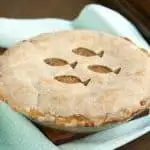






Chatty
Friday 30th of December 2022
I have this in my oven right now and it smells delicious! I used two pounds of ground pork as my pie pans are deep. The amount of filling seems perfect. I can't wait to try this!
Sarah - Curious Cuisiniere
Saturday 31st of December 2022
We hope you enjoy it!
CJ Plourde
Wednesday 21st of December 2022
Hi Sarah, I grew up in Daigle, Maine—near Fort Kent and tourtiere was also made using a combination of pigs feet, which was really incredible. I found a local recipe here in Montréal a couple years ago and made it. it was great but a bit heavy for my liking so this year I’m going to make your recipe which sounds so savory with all those herbs. if you ever run across a pig’s feet recipe from Maine, please consider sharing it. There was something so tasty about those sticky pigs feet and it was so Delicious! Not something to eat regularly but it would be great just to have once a year. Merci
Sarah - Curious Cuisiniere
Thursday 22nd of December 2022
How interesting. I will have to look through some of my Grandma's cookbooks and see if any of them mention using pigs feet. Thanks for sharing!
Lizzy
Thursday 13th of October 2022
Thank you for this recipe. I used to live in Ottawa and towards December, colleagues would come in on a Monday and talk about how many pies they had made over the weekend. Numbers up to thirty-something would be bandied about! Fruit pies, mostly, but of course, many, many tourtieres! I've printed out your recipe and will try it myself this Christmas (2022). I look forward to tasting it as yours looks like the real thing.
Sarah - Curious Cuisiniere
Thursday 13th of October 2022
Hi Lizzy. What fun memories! We hope you enjoy our recipe!